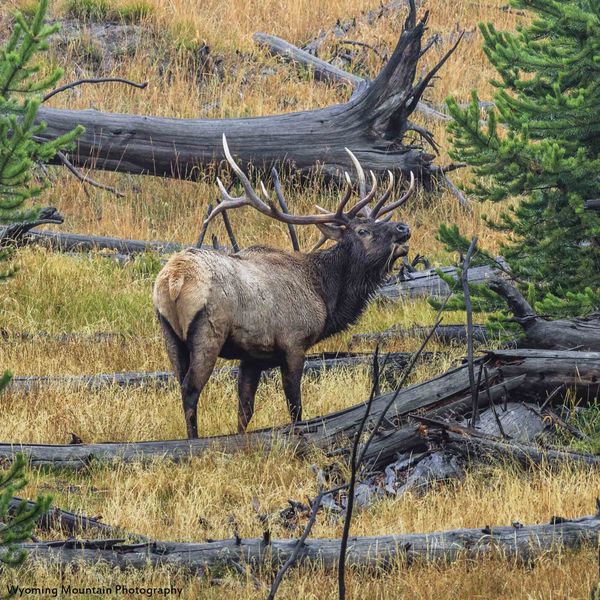By Museum of the Mountain Man Staff
Here a circumstance occurred which furnished the subject for a good joke upon our green Irish camp keeper. … It was the commencement of the rutting season with the elk, when the bucks frequently utter a loud cry resembling a shrill whistle, especially when they see anything of a strange appearance. We had made our beds at night on a little bench between two small, dry gullies. The weather was clear and the moon shone brightly. About ten o’clock at night, when I supposed my comrades fast asleep, an elk blew his shrill whistle within about 100 yards of us. I took my gun, slipped silently into the gully and crept toward the place where I heard the sound, but I soon found he had been frightened by the horses and ran off up the mountain. On turning back I met Allen, who, hearing the elk, had started to get a shot at him in the same manner I had done without speaking a word. We went back to camp, but our camp keeper was nowhere to be found. We searched the bushes high and low ever and anon calling for “Conn,” but no “Conn” answered. At length Allen, cruising through the brush, tumbled over a pile of rubbish, when lo! Conn was beneath, nearly frightened out of his wits. “Arrah! an’ is it you, Allen?” said he trembling as if an ague fit was shaking him. “But I thought the whole world was full of the spalpeens of savages. And where are they gone?” It was near an hour before we could satisfy him of his mistake, and I dare say his slumbers were by no means soft or smooth during the remainder of the night.[1]
In this journal entry, mountain man Osborne Russell shares a rare detail from life in the fur trade era, the whistle, or bugle, of a bull elk during the rut. His account stands out not only for its humor and storytelling but also for capturing a rare and specific moment of trapper life.
The scarcity of similar observations about elk bugling in other journals does not suggest that trappers failed to notice or appreciate these sounds. Fur trappers and mountain men undoubtedly heard the bugles of elk, an unforgettable sound that marks the rutting season in the Rocky Mountains. More likely, the absence reflects differences in what individuals chose to record, or what has survived in print. Most fur trade journals focus on trade logistics, survival, mapping, or relationships with Native peoples, subjects far more relevant to daily life than the bugle of an elk on a moonlit night.
Russell, however, offers something unique: a brief account of what life in the fur trade sometimes sounded like, and a humorous glimpse into how trappers experienced those moments. Through his narrative, we can imagine the moonlit camp, the sudden stillness after the elk’s call, and the laughter of companions once fear gave way to relief.
In the Museum’s ongoing work to bring history to life, accounts like Russell’s help us understand not just what mountain men did, but what they and their comrades heard, felt, and feared, and allow us to imagine just how constant those fears must have been in the mountains. Yet Russell’s journal reminds us that even in an era of hardship and danger, there was room for curiosity and humor, moments that bring these historical figures to life for us today.
[1] Osborne Russell, Journal of a Trapper, 1834–1843, (Boise, ID: Syms-York Company, Inc., 1921) 70. “Spalpeens” is an Irish word roughly translated as “rascals.”

